Odds are, if you’ve spent time on horses, you’ve also come off in some spectacular way. Trauma to any part of your body affects how your muscles function to support you against gravity and can often result in back pain. Post-injury, our body adapts to: a) keep our eyes level in gait; and b) keep us feeling ‘safe.’ Compensation or adaptation to injury therefore affects what ranges of motion we allow our body to access.
To sit balanced on a horse we need mobile but stable joints and a spine that allows for normal range of motion, free of pain. To protect our backs as riders, we need stability anteriorly in our core, and posteriorly in our mid-backs.
Deadbugs
To strengthen your core and reinforce your dynamic mobility, the exercise ‘deadbugs’ is ideal. Start by lying on your back on a firm surface with your knees bent. Reach actively to the ceiling with both hands and then straighten both legs within your hamstring limits (photo 1). Hold for 30 seconds. Your lower back should be pressed firmly to the ground, avoiding any back extension. You should feel your core engage to keep your legs and arms in the air. Do 1-3 sets.
To progress this exercise, move perpendicular to a wall and bend your elbows and push your hands into the wall. Set your legs up as before, and alternately allow one leg to drop to the floor, controlling the descent and keeping your back flush to the floor (photo 2). Do 1-3 sets of 12 reps total (six per side).
Blackburn
To strengthen your mid-back and support strong and retracted shoulders, the ‘Blackburn’ is an excellent exercise which balances the core work. The goal is to transition smoothly from one position to the next while controlling the scapular/shoulder blade position against gravity as you move.
Start by lying face down on the floor, chin tucked with forehead in contact with the floor, and toes dorsi-flexed towards your head. Tuck your pelvis in a posterior tilt. Begin with hands clasped over your glutes and set your shoulder blades back and down. Lift your hands off your glutes in an “I” position (photo 3). Hold for five seconds. Slowly and smoothly transition through the next three positions – “T”, “Y” and “W” (photos 4,5, and 6), holding each for five seconds while keeping your shoulders back and down, and hands off the floor. Do 1-3 sets. If this is difficult to sustain, train yourself by resting in between each arm position. You should feel your lower fibres trapezius muscle working to stabilize your back and shoulders.
The key to avoiding pain is maintaining strength and mobility as part of a daily intentional functional movement practice, to keep you stable and strong on your horse. Direct questions to JLBCamp@gmail.com.

